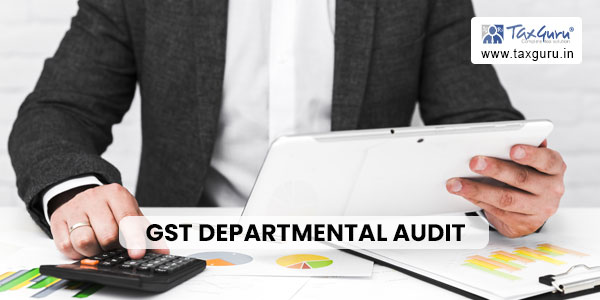A departmental GST audit is a crucial process that ensures businesses comply with GST regulations. This article provides a comprehensive checklist for businesses to follow during a GST audit, covering aspects such as sales, purchases, reconciliations, and required documentation.
Legal Provision
- The Commissioner of CGST/SGST or any officer authorized by him is authorized to conduct an audit of a taxpayer under GST laws.
- The taxpayer is required to receive a Notice in Form GST ADT-01(Rule 101(2)) at least 15 days before the audit is conducted.
- The notice contains the Period of audit (duration for which audit would be conducted e.g. F.Y-2017-18,2018-19),
- When the audit is deemed to have commenced only after the first submission by the taxpayer.
- The information regarding the designated person / authorized person for coordination with the GST department needs to be given to the department on behalf of the registered person.
- The audit is required to be completed within 3 months from the date of commencement of audit (Commission has authority to extend for further 6 month – reasons to be recorded in writing).
- The GST Officer can conduct the audit at the Taxpayer’s place of business or at his office.
- After verifications of books of accounts of respective year, based on the information provided by the taxpayer and based on his independent findings, the auditor issues an observation letter to the taxpayer.
- The taxpayer should file a proper reply (along with working and proof) against the observation.
- Based on the reply to the observation, the officer issues a draft audit report and then issues a final audit report(ADT- 02) within 30 days.
- Where the audit results in detection of tax not paid or short paid or erroneously refunded, or input tax credit wrongly availed or utilised, the proper officer may initiate action under section 73 or section 74 – [Superintendent for S. 73 and AC/ DC for S.74]

Check list for Departmental GST Audit under Section 65
Sales\Outward –
√ Turnover reconciliation – Profit and Loss (Income from Sales + Other Income) Vs Turnover of GSTR9.
√ Outward register along with HSN codes and GST Rates.
√ In the outward register, enter the GSTR3B and GSTR1 month against each invoice, it will be easy to explain to the GST officer.
√ Reconciliation – Books Vs GSTR3B Vs GSTR1 Vs GSTR9
√ Eway bill issued details against sales invoices.
√ IRN details against Sales Invoices.
√ Details of Export sales along with FIRC (Foreign Inward Remittance Certificate)
√ Details of RCM which is paid under RCM
√ Details of FA sales (which is should be match with FA Schedule – deletion of asset),if any difference then reconciliation statement required.( (These details are asked by the officer as they want to check whether liability has been discharge on all Invoice and if capital goods sold with in 5 year then whether ITC has been reversed Under Rule 40 (2) of the CGST Rules it has been prescribed that for the purpose of Section 18 (6).
√ Details\ledger copies of Income from other source\other income, e.g – Scrap sales, Interest Income (These details are asked by the officer as they want to check whether liability has been discharged on all invoices or income).
√ List of Credit notes along with original Invoice reference number and dates.
√ List required – If said any invoices\credit notes filed or amendment in subsequent year (before due date of filing) and interest applicable.
√ List of ISD Invoices or Cross charge Invoices along with working of cross charges (Intra Company and Inter companies (Related Parties).
√ List of Import of service from related Parties
√ Reconcile 27Q with outward register (whether RCM paid on foreign payment)
Inward\Purchases
√ Reconciliation of Books Vs GSTR3B Vs GSTR9
√ Inward register along with HSN Code\Nature of Expenses\Bifurcation of ITC availed (Goods – Capital Goods – Service) \GST Rates.
√ In the inward register, enter the GSTR3B month against each invoice, it will be easy to explain to the GST officer.
√ Payment date against purchase invoice (These details are asked by the officer as they want to check whether payment made within 180 days or not)
√ Invoice wise GSTR2A reconciliation, if vendor has not filed invoice in GSTR1 but liability paid to GST department then get certificate from vendor as per circular 183(Jul-17 to 8th Oct 2019) and for other period – 9th Oct 2019 to 31-12-2021 – get certificate as per rule 36(4) – Rule 36(4) provided for a particular limit % to avail ITC in respect of mis-match invoices. Now Circular imposes additional condition to obtain a certificate / declaration for such ITC availed.
√ List of Imports and bill of entries, reconcile bill of entries with GSTR2A,if not match then keep hardcopies of missing bill of entries ready for verification.
√ Identity invoices of block credit/ineligible ITC which ITC availed and reverse the ITC along with interest.
√ Reconciliation of ITC on RCM availed, and liability paid under RCM, if any differences then annexure along with documentation proof keep ready for explanation.
√ Review all GLs on which RCM is applicable and check why RCM has not been discharged on invoices, e.g – Legal and Professional fees, Advocate fees, Sponsorship, Security charges, GTA, Import of services).
√ The registered person engaged in making taxable, as well as exempted supplies, is required to work out the reversal of ITC.
√ Review the details of Goods lost, personal consumption, gifts, free samples, stock written off by way of disposal etc, if any need to reverse the reverse the same along with interest.
Documentation
√ Invoice copies of purchases and sales of respective year.
√ Copes of Self-generated Invoices (RCM, Cross Charge)
√ Copy of GSTR9, GSTR9C, GSTR1 and GSTR3B.
√ Financial of respective year
√ Copy of 27Q
√ Copy of 15CA ,15CB and 3CEB.
Note – Before going in front of the GST Officer, check and know the following in detail.
- You should know about business operation.
- Do a complete study of the financials and notes, see if there are any points where GST liability can arise.
- Check all documents which is mentioned in documentation,
- When submitting any document, do a 360-degree check to see where a similar result might occur.
Conclusion: A thorough understanding of the legal provisions and a well-prepared checklist are essential for a successful departmental GST audit. Following the outlined checklist for sales, purchases, reconciliations, and proper documentation ensures compliance and a smoother audit process for businesses.





